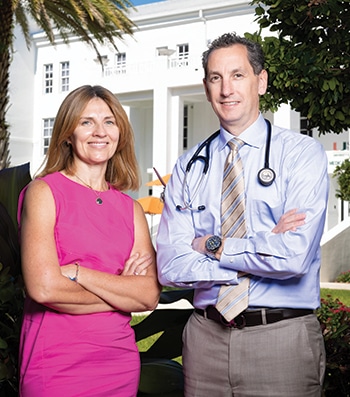Karen Titus
May 2023—Behold the common coin. Note its two sides, its easy flippability.
Here is Joseph Pizzolato, MD, with the first coin toss. Given the expanded use of biomarkers with a variety of tumors, and constantly evolving assays, how hard is it for medical oncologists to navigate testing?
“It’s not difficult at all now,” says a cheerful Dr. Pizzolato, medical director of the comprehensive therapeutic unit of Sylvester Comprehensive Cancer Center, University of Miami Health System, as well as medical director of the Aventura satellite at Sylvester.
With third-party companies integrating test ordering directly into electronic medical records, he adds, “It’s getting even easier to order tests and see the results.”
Agreed, says his colleague Rhonda Yantiss, MD, director of surgical pathology, Department of Pathology and Laboratory Medicine, University of Miami Miller School of Medicine. And therein lies the problem. “It’s kind of a mess,” she says.
In practice, precision medicine is becoming both more and less precise. This is playing out in a number of scenarios, but these days HER2 testing in colorectal cancer offers an especially vivid example of the complexities labs face.
Stage four colorectal cancer itself is complicated. Some patients will respond to the EGFR inhibitors such as cetuximab. But lacking a correlation between EGFR immunoexpression and a therapeutic response, “there isn’t any value to performing immunohistochemistry for EGFR when considering a targeted therapy,” Dr. Yantiss explains. “We do look for downstream alterations in EGFR-mediated signaling, particularly KRAS mutations,” since the presence of such mutations renders EGFR-targeted therapies ineffective. Close to half of colon cancers have such mutations. “Regardless of whether the receptor is blocked, if everything downstream of that is turned on, that cellular mechanism is still going to be running.”
HER2, which belongs to the same superfamily of tyrosine kinases as EGFR, is adding to the story. Some patients with wild-type KRAS still have cetuximab-resistant tumors and, in this situation, a lack of therapeutic response may be due to HER2 amplification. In these cases, patients may respond to a combination of agents that target the HER2 receptor.
Recent clinical trials have established the usefulness of HER2 in advanced colorectal cancer therapies, says Antonia Sepulveda, MD, PhD, professor and chair, Department of Pathology, and medical director of the George Washington University Hospital laboratories. One of the first was the HERACLES trial, which looked at trastuzumab and the EGFR/HER2 inhibitor lapatinib. Another trial, MyPathway, evaluated trastuzumab and pertuzumab. The Mountaineer trial used trastuzumab and tucatinib, a combination that received accelerated FDA approval in January. Yet another trial, DESTINY-CRC01, looked at the antibody-drug conjugate trastuzumab deruxtecan. Other trials are ongoing.
Dr. Sepulveda’s summary of this work is sweet as well as short: “These trials offered significantly improved objective response rates on these patients.”
The number of affected patients, at first blush, might seem small. HER2 is present in three to five percent of colorectal cancers, says Dr. Pizzolato. That sounds small but isn’t, he says, noting that five percent is another way of saying “one in 20.” As a GI oncologist, “I certainly see more than 20 different colorectal cancers a week.”In addition, Dr. Sepulveda says, the number rises, to about 14 percent, among cases that are RAS/RAF wild-type. “That’s a level of frequency that becomes more relevant in clinical practice.”

Dr. Rhonda Yantiss and Dr. Joseph Pizzolato at the Sylvester Cancer Center at the University of Miami Miller School of Medicine. Of cancer biomarker testing, Dr. Yantiss says pathologists need to be the gatekeepers. “But that means we have to improve our own efficiency and actively engage our oncology colleagues,” she says. [Photo by: Joshua Prezant]
Stage four CRC is dire. Targeted therapies can work for many patients who didn’t or no longer respond to cetuximab. Physicians and patients are eager to test for HER2 overexpression or amplification.
“This is pretty exciting as we begin to understand more and more we’ve got good targets for HER2 in colon cancer,” says Dr. Pizzolato. “We’re getting much better at finding niches for targeted therapies. But we can’t get better unless we test”—not only to plan first-line and subsequent-line therapies, he says, but also to look at clinical trials options. “Testing allows us to pick our regimens wisely.”
But test how?
And given that recent data indicate the majority of labs are not testing for HER2 in these cases, an equally big question looms: Why not?
Testing for HER2 seems to be a self-evident step, but like a recipe instruction to “Season to taste,” there’s nothing formulaic about it.
A 2021 CAP survey (Hagemann IS, et al. Arch Pathol Lab Med. Published online Dec. 20, 2022. doi:10.5858/arpa.2022-0229-CP) assessed current testing practices for ERBB2/HER2 in colorectal carcinoma as well as endometrial serous carcinoma. For CRC, 20.2 percent of responding labs (239 of 1,185) performed in-house HER2 testing.
Of the remaining 946 labs not doing HER2 testing, 8.4 percent said they planned to start in 2021, 7.2 percent planned to start after 2021, and 64.2 percent said they had no plans to start.
The results weren’t necessarily surprising to coauthor Anna Yemelyanova, MD, who instigated the study as a member of the CAP Molecular Oncology Committee. “Our expectations, unfortunately, were fulfilled,” says Dr. Yemelyanova, chief of gynecologic pathology and professor of pathology and laboratory medicine, Department of Pathology and Laboratory Medicine, Weill Cornell Medicine.
Such low numbers are concerning to medical oncologists as well. Says Dr. Pizzolato: “I can’t stress this enough: We have to keep testing. Less than 100 percent doesn’t cut the mustard. We need every single person tested in the metastatic setting.”
For those that were doing testing, 82 percent of them did so only at the clinician’s request. Less than 10 percent (8.4 percent) said they performed it for all metastatic cases. The most commonly used primary test was IHC (82.3 percent), with reflex to ISH for equivocal results.
Dr. Yemelyanova
The survey also pointed to variable practices among labs that were doing testing—again, this was not a surprise, says Dr. Yemelyanova, given the lack of formal guidance for HER2 testing in CRC. That forces labs to extrapolate and adopt practices from other tumor types that may have no relevance to CRC, at least based on some of the clinical trial data.
Breast cancer testing algorithms, for example, have benefited from abundant data, multiple rounds of guidelines, and refinements in how results are reported. Attempts to expand testing to other tumor types, including CRC, are playing catch-up as targeted therapies take off. “We have to be careful about extrapolating practices to other tumor types as they might be biologically different tumors,” says Dr. Yemelyanova, “and the well-established trial-proven algorithms that work for some tumor sites may not work for others.”
Moreover, she notes, as the breast guidelines evolved, the thresholds for scoring have changed significantly. Unless pathologists are tracking updates closely, it can be hard to stay current, creating another challenge for anyone trying to adapt breast thresholds to colorectal cancers.
And though the guidelines for gastroesophageal and GE junction testing may seem to be applicable to CRC, some clinical trials, such as HERACLES, used a different scoring scheme, Dr. Yemelyanova says.
In the CAP survey, 49.4 percent of labs reported using 2016 CAP/ASCP/ASCO HER2 guidelines for gastroesophageal adenocarcinoma for scoring CRC HER2 cases, 30 percent followed the scoring used in the HERACLES trial, and 16.3 percent used the ASCO/CAP 2018 guidelines for breast carcinoma.
The lack of formal guidance may contribute to labs’ hesitancy to test, says Dr. Yemelyanova. “For validation in the lab, you absolutely cannot run a clinical trial,” although labs can try to duplicate the testing algorithm and scoring thresholds used in the trials.
One of the common approaches to validation is to send out specimens to a reference laboratory, then validate tests performed in-house against the external results. But those reference labs are also practicing in the setting of the absence of the formal guidelines, she says. The same drought will affect the entire kingdom—the royals, landed gentry, and peasants alike. “It’s the same sort of void,” says Dr. Yemelyanova. “It’s a major obstacle.”
Fundamentally, Dr. Sepulveda says, testing in CRC—when it’s done—can follow the well-traveled path of immunohistochemistry, FISH, or SISH. Also being added to the mix are next-generation sequencing panels that provide copy number amplifications of HER2. “It’s already being widely used in the clinic,” Dr. Sepulveda says.Many laboratories have applied knowledge gained from experience with GE junctional and gastric adenocarcinomas to HER2 testing in CRC, says Dr. Yantiss. The ToGA trial mapped out the criteria used to assess immunohistochemical expression of HER2 among GE junctional and gastric adenocarcinomas, she says, as well as when to perform HER2 in situ hybridization when immunostain results were equivocal. But the scoring system was not revalidated for CRC.
The HERACLES trial was the first big study to look at HER2 immunoexpression and HER2 amplification in colon cancer. “The authors created an algorithm for assessing the immunostain results and when to reflex to in situ hybridization, and also defined situations when you didn’t need to do that,” says Dr. Yantiss. These criteria are somewhat different from those endorsed by the CAP, ASCO, and others for assessing upper GI tract cancers. Although there is a fair amount of overlap between the testing criteria used in the HERACLES trial and those promoted by the CAP, Dr. Yantiss says, they differ with respect to recommendations for in situ hybridization in equivocal cases.
Most of the trials follow the 2016 CAP guidelines for gastroesophageal adenocarcinoma. By this criteria, Dr. Sepulveda notes, a tumor is considered positive if it is HER2 IHC 3+ positive, or when it is HER2 IHC 2+ positive and positive by FISH.
The HERACLES trial, however, stands apart from the others, Dr. Sepulveda continues. A tumor is considered positive if it is HER2 IHC 3+ in greater than 50 percent of the cells, or (as in the other criteria) is HER2 IHC 2+ and amplified in greater than 50 percent of cells by FISH. “Importantly, the NCCN guidelines decided to recommend the use of HERACLES criteria,” she says, adding, “We can argue that.” These are stringent criteria. “There are some data from trials that seem to indicate that these very strict criteria do not seem to lead to better outcomes” compared with using the criteria in the 2016 CAP guidelines, Dr. Sepulveda says.
Guidelines for CRC molecular testing, including HER2 testing, warrant an update. The ASCP/CAP/AMP/ASCO guidelines were published in 2017, i.e. pre-HER2 (Sepulveda AR, et al. Arch Pathol Lab Med. 2017;141[5]:625–657). Dr. Sepulveda, the lead author on those guidelines, says, “We are in discussions to update them.”

Dr. Sepulveda
Dr. Sepulveda says she suspects most pathologists are reporting 10 percent positive cells (as recommended in the 2016 criteria), not 50 percent. Regardless, she says, when reporting HER2 CRC results, “I would suggest that it’s important to indicate what percentage of tumor cells are positive to help the oncologist decide what drug combination they would be using for that patient.”
There might be another stair to trip on as labs consider expanded HER2 testing: HER2-low. A recent study (Lang-Schwarz C, et al. Pathol Res Pract. 2023;244:154417) looked at more than 300 CRC cases (stages one through four). Nearly half were defined (using the HERACLES criteria) as HER2-low (IHC 1+ or 2+/FISH negative). Compared with HER2-negative cases, says Dr. Yantiss, “they tended to have more tumor-infiltrating lymphocytes, which we know is a good prognostic indicator, as well as less tumor budding, which is an adverse prognostic indicator.
“It’s too early to tell if this is going to mean anything in the colon, but people are talking about it,” she says.
Dr. Sepulveda spies another fork in the road. Until now, the standard HER2 testing practice of doing IHC, followed by FISH, has worked well and stood the test of time, she says. But the old order could be upended, given the eagerness with which medical oncologists are turning to NGS panels. CAP TODAY Pathology/Laboratory Medicine/Laboratory Management
CAP TODAY Pathology/Laboratory Medicine/Laboratory Management
